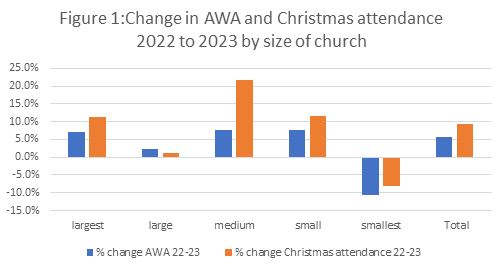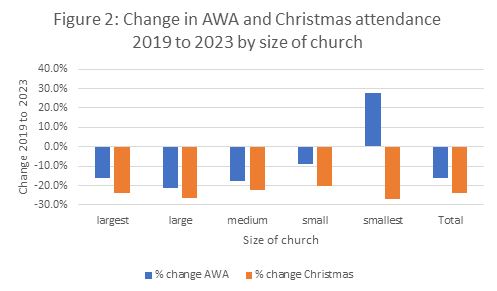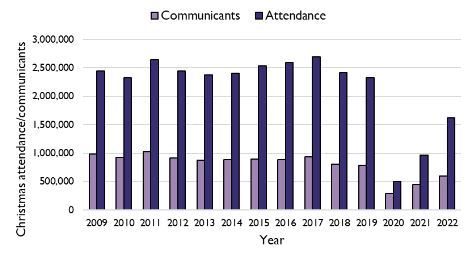Anecdotally, several people have commented on seeing an increase in numbers of people attending their special Christmas services in December 2023. The press has similarly reported increases seen in cathedrals. E.g. Times Sunday 21 January 2024. ‘Faithful are flocking back to cathedrals’. Asked by the Times for their Christmas attendance figures, ‘Anglican cathedrals reported numbers that were not only up on the previous three years but were in many cases even higher than those in 2019, the last Christmas before the pandemic.’ Is this increase seen in our Statistics for Mission (SfM) figures for Oxford Diocese and if so, how should we interpret this?
I have analysed Christmas 2023 attendance from Statistics for Mission returns at 1 February (when SfM response was 64%). I compared this sample of returns against their Christmas attendance figures for 2019 and 2022 using the same methodology as used for the October comparisons.
As seen in Figure 1 below, comparing 2023 Christmas attendance in the sample churches with their figures from 2022 shows an increase between 2022 and 2023 in all sizes of church except the smallest. Overall, the increase between 2022 and 2023 was 9% compared to an increase of 6% in their Average Weekly Attendance (AWA) based on their October attendance figures.

Similarly, Christ Church cathedral Oxford saw an increase in Christmas attendance between 2022 and 2023, a larger increase of 18% although we know they held one extra carol service in 2023 (and one fewer Eucharist).
Comparing 2023 Christmas attendance in the sample churches with their figures from Christmas 2019 (immediately before the pandemic) in Figure 2, however, shows that Christmas figures compared with 2019 have not recovered as much as have the AWA October figures. Overall Christmas attendance was at 76% of the 2019 level, whereas the AWA was at 84% of the 2019 level. The pattern for Christmas attendance was similar in all sizes of church.

Christ Church cathedral, however, saw a higher Christmas attendance in 2023 than in 2019, largely due to running 5 carol services in 2023 compared to 3 in 2019.
So, the analysis does show that between 2022 and 2023 Christmas attendance increased more than the percentage increase in AWA. Why then does the 2019 to 2023 for churches comparison not show the same increase, and is this a ‘real’ increase or do other factors come into play?
We do know that Christmas attendance figures are influenced by the effects of weather and on which day of the week Christmas Eve falls; factors that do not affect the October AWA.
Christmas Eve 2023 fell on a Sunday, and we know that Christmas figures are higher when Christmas Eve is on a Sunday provided the weather is OK. The last time Christmas Eve was on a Sunday was 2017. Figure 3 below, taken from national Statistics for Mission figures given in the Statistics for Mission 2022 report, shows that 2017 saw the highest Christmas figures over the period 2009 to 2022.

Source: Statistics for Mission 2022, Dr Ken Eames, Data Services, 2023
There are several suggested reasons for the “day of the week” effect. Partly it is due to a decision taken many years ago include Christmas Eve attendance with Christmas Day for Statistics for Mission returns. This was done to include Midnight Mass attendance (whatever time it happens!) but this does mean the figures are also affected by carol service scheduling.
Christmas Eve being a Sunday also means that Christmas Eve was Advent 4, which makes a difference in some churches that do not do “Christmas” things during Advent. Therefore, their carol services could have been on the 24th rather than earlier, hence increasing Christmas attendance.
Attendance for Christ Church Cathedral showed an increase associated with an increase in the number of carol services held. Unfortunately, we do not collect from churches their number of Christmas services so we cannot see whether there is any association between changes in attendance associated with changes in numbers of services offered.
Given this lack of a linear trend in Christmas attendance, but a more cyclical one, the change between 2019 and 2023 being smaller percentage change than the change in AWA is not necessarily unexpected. Christmas Eve in 2019 was a Tuesday which also benefits from people travelling and finishing Christmas preparation the previous weekend, whereas Christmas Eve in 2022 was a Saturday, so it is likely that people were finishing Christmas preparations and travelling that day.
This analysis has shown that yes, we did see an increase in our Christmas attendance in 2023. However, given that I have also shown from the time series that Christmas attendance is much more subject to variation than just about anything else we measure, thought to be due to the day of the week and weather. In addition, the figures from our cathedral suggest that Christmas attendance is affected by the number of services offered, but we have no information from churches to analyse this. Finally, we are still in recovery from a pandemic, so it’s impossible to tell how much of the growth seen in 2023 is related to continued post-pandemic recovery, how much due to changing the number of services offered, how much is due to weather and Christmas Eve falling on a Sunday, and how much is a “genuine” increase in Christmas attendance trends.
Bev Botting
5 February 2024
